2004 FORD MUSTANG brakes
[x] Cancel search: brakesPage 2 of 240
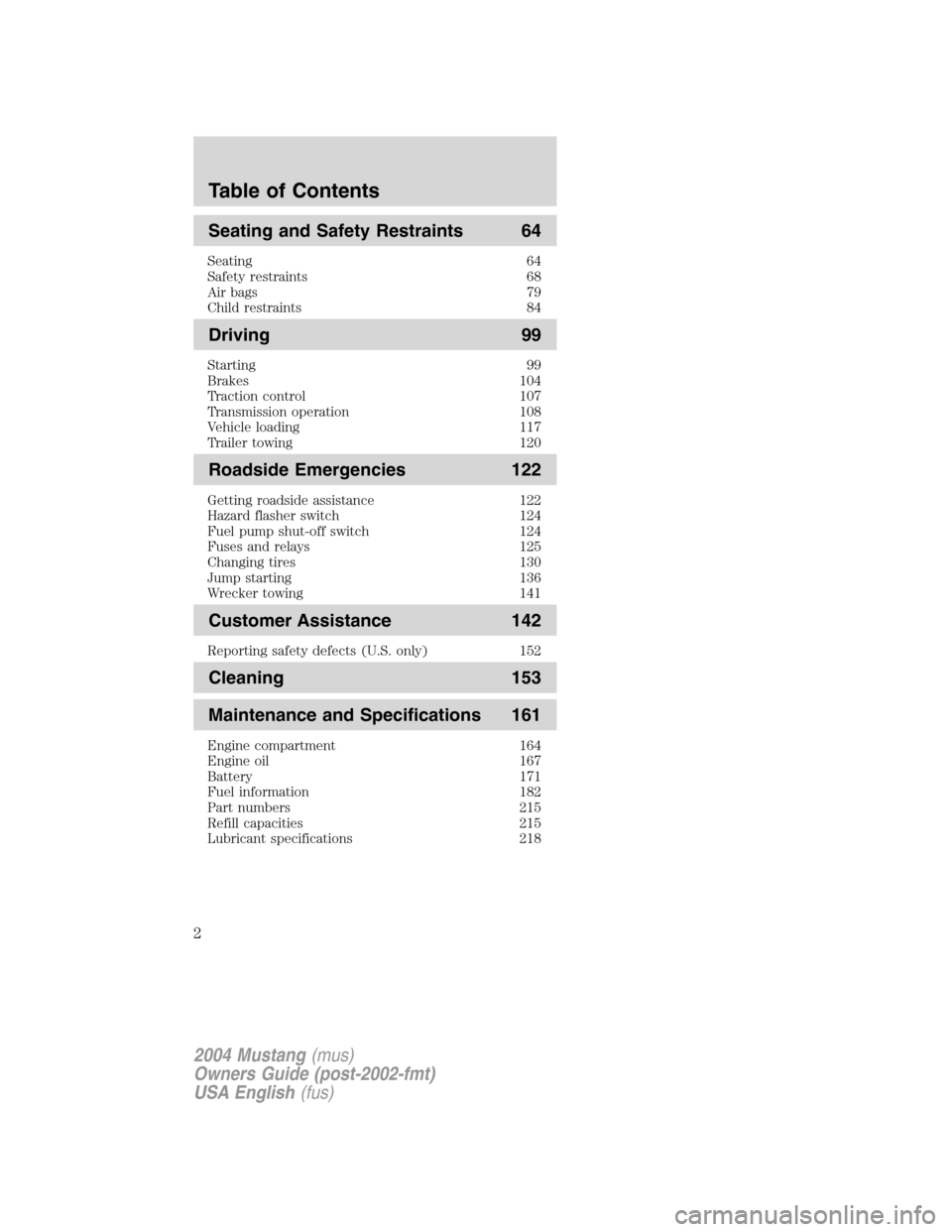
Seating and Safety Restraints 64
Seating 64
Safety restraints 68
Air bags 79
Child restraints 84
Driving 99
Starting 99
Brakes 104
Traction control 107
Transmission operation 108
Vehicle loading 117
Trailer towing 120
Roadside Emergencies 122
Getting roadside assistance 122
Hazard flasher switch 124
Fuel pump shut-off switch 124
Fuses and relays 125
Changing tires 130
Jump starting 136
Wrecker towing 141
Customer Assistance 142
Reporting safety defects (U.S. only) 152
Cleaning 153
Maintenance and Specifications 161
Engine compartment 164
Engine oil 167
Battery 171
Fuel information 182
Part numbers 215
Refill capacities 215
Lubricant specifications 218
2004 Mustang(mus)
Owners Guide (post-2002-fmt)
USA English(fus)
Table of Contents
2
Page 47 of 240
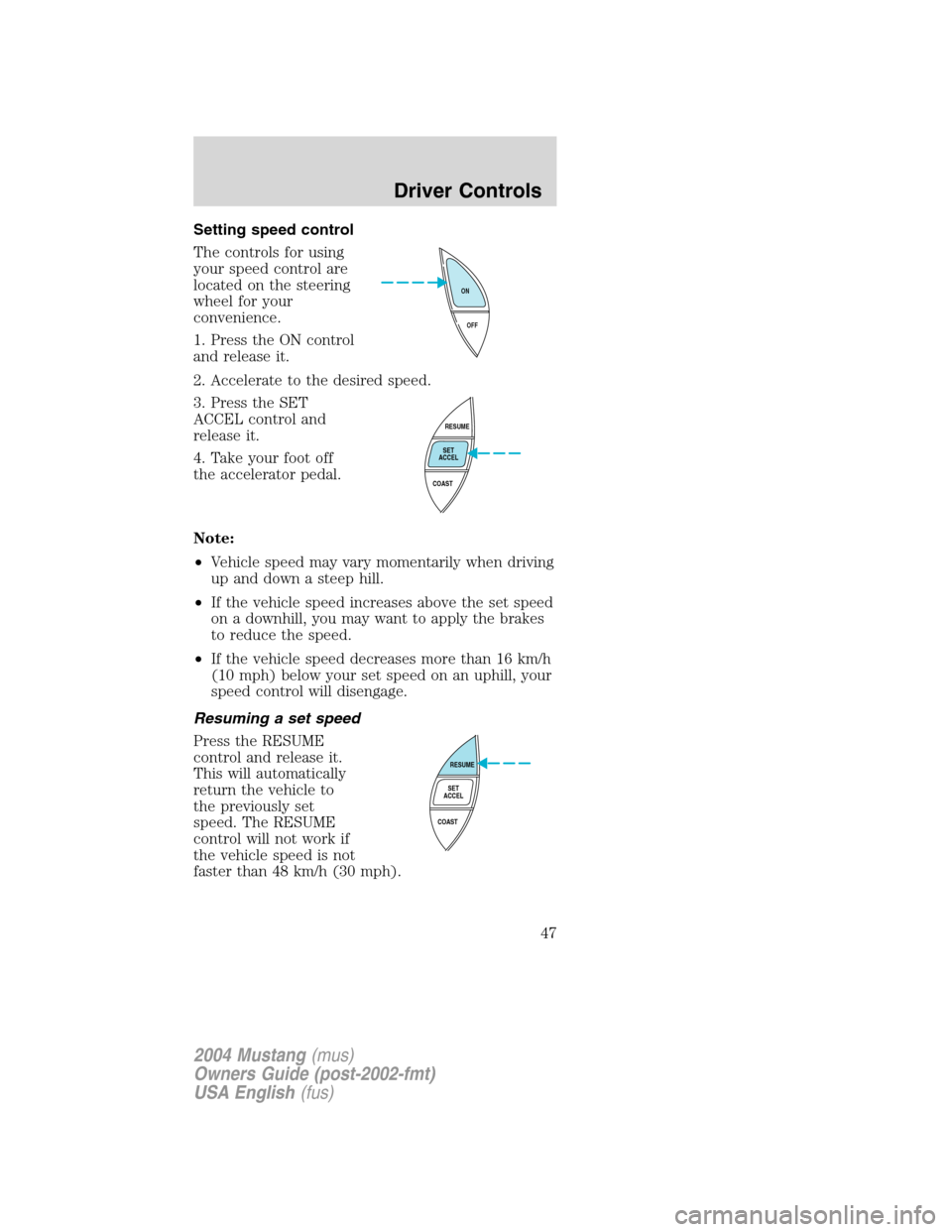
Setting speed control
The controls for using
your speed control are
located on the steering
wheel for your
convenience.
1. Press the ON control
and release it.
2. Accelerate to the desired speed.
3. Press the SET
ACCEL control and
release it.
4. Take your foot off
the accelerator pedal.
Note:
•Vehicle speed may vary momentarily when driving
up and down a steep hill.
•If the vehicle speed increases above the set speed
on a downhill, you may want to apply the brakes
to reduce the speed.
•If the vehicle speed decreases more than 16 km/h
(10 mph) below your set speed on an uphill, your
speed control will disengage.
Resuming a set speed
Press the RESUME
control and release it.
This will automatically
return the vehicle to
the previously set
speed. The RESUME
control will not work if
the vehicle speed is not
faster than 48 km/h (30 mph).
OFF ON
RESUME
SET
ACCEL
COAST
RESUME
SET
ACCEL
COAST
2004 Mustang(mus)
Owners Guide (post-2002-fmt)
USA English(fus)
Driver Controls
47
Page 71 of 240
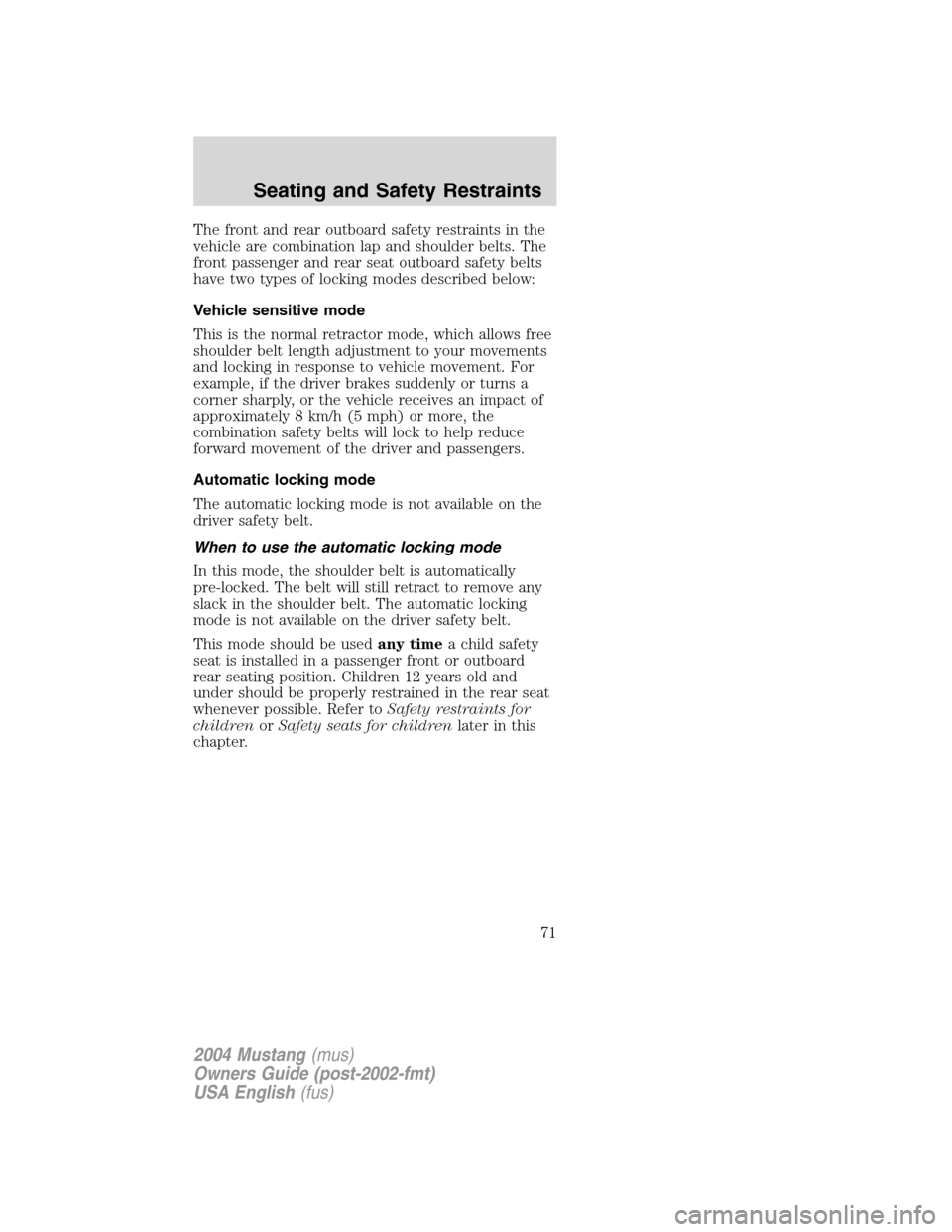
The front and rear outboard safety restraints in the
vehicle are combination lap and shoulder belts. The
front passenger and rear seat outboard safety belts
have two types of locking modes described below:
Vehicle sensitive mode
This is the normal retractor mode, which allows free
shoulder belt length adjustment to your movements
and locking in response to vehicle movement. For
example, if the driver brakes suddenly or turns a
corner sharply, or the vehicle receives an impact of
approximately 8 km/h (5 mph) or more, the
combination safety belts will lock to help reduce
forward movement of the driver and passengers.
Automatic locking mode
The automatic locking mode is not available on the
driver safety belt.
When to use the automatic locking mode
In this mode, the shoulder belt is automatically
pre-locked. The belt will still retract to remove any
slack in the shoulder belt. The automatic locking
mode is not available on the driver safety belt.
This mode should be usedany timea child safety
seat is installed in a passenger front or outboard
rear seating position. Children 12 years old and
under should be properly restrained in the rear seat
whenever possible. Refer toSafety restraints for
childrenorSafety seats for childrenlater in this
chapter.
2004 Mustang(mus)
Owners Guide (post-2002-fmt)
USA English(fus)
Seating and Safety Restraints
71
Page 104 of 240
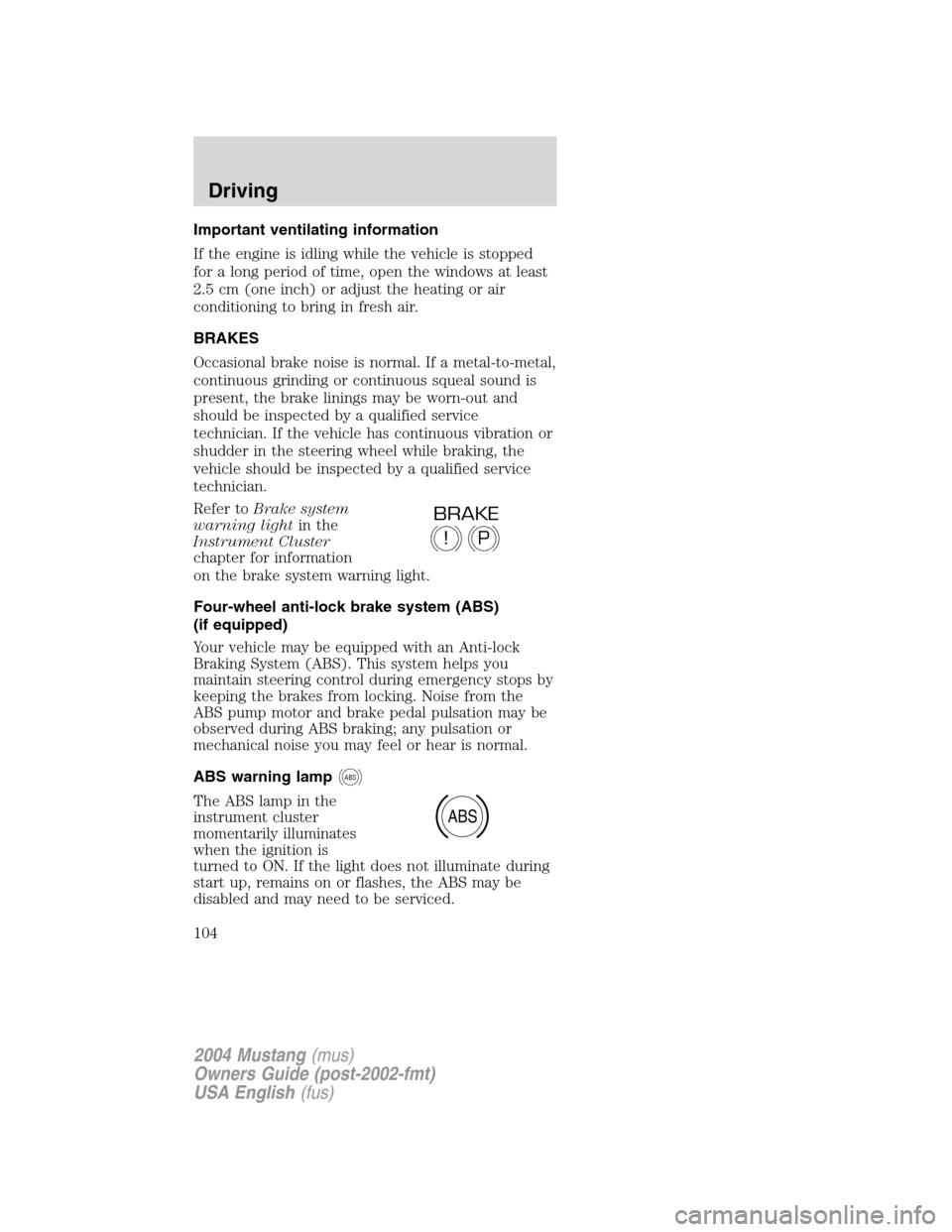
Important ventilating information
If the engine is idling while the vehicle is stopped
for a long period of time, open the windows at least
2.5 cm (one inch) or adjust the heating or air
conditioning to bring in fresh air.
BRAKES
Occasional brake noise is normal. If a metal-to-metal,
continuous grinding or continuous squeal sound is
present, the brake linings may be worn-out and
should be inspected by a qualified service
technician. If the vehicle has continuous vibration or
shudder in the steering wheel while braking, the
vehicle should be inspected by a qualified service
technician.
Refer toBrake system
warning lightin the
Instrument Cluster
chapter for information
on the brake system warning light.
Four-wheel anti-lock brake system (ABS)
(if equipped)
Your vehicle may be equipped with an Anti-lock
Braking System (ABS). This system helps you
maintain steering control during emergency stops by
keeping the brakes from locking. Noise from the
ABS pump motor and brake pedal pulsation may be
observed during ABS braking; any pulsation or
mechanical noise you may feel or hear is normal.
ABS warning lamp
ABS
The ABS lamp in the
instrument cluster
momentarily illuminates
when the ignition is
turned to ON. If the light does not illuminate during
start up, remains on or flashes, the ABS may be
disabled and may need to be serviced.
P!
BRAKE
ABS
2004 Mustang(mus)
Owners Guide (post-2002-fmt)
USA English(fus)
Driving
104
Page 106 of 240

Parking brake
To set the parking
brake (1), pull the
parking brake handle
up as far as possible.
The BRAKE warning
lamp will illuminate and
will remain illuminated
until the parking brake
is released.
To release, press and hold the button (2), pull the
handle up slightly, then push the handle down.
Always set the parking brake fully and make
sure that the gearshift is securely latched in
P (Park) (automatic transmission) or in 1 (First)
(manual transmission).
If the parking brake is fully released, but the
brake warning lamp remains illuminated, the
brakes may not be working properly. See your
dealer or a qualified service technician.
STEERING
To prevent damage to the power steering system:
•Never hold the steering wheel at its furthest
turning points (until it stops) for more than a few
seconds when the engine is running.
•Do not operate the vehicle with a low power
steering pump fluid level (below the MIN mark on
the reservoir).
If the power steering system breaks down (or if the
engine is turned off), you can steer the vehicle
manually, but it takes more effort.
If the steering wanders or pulls, check for:
•an improperly inflated tire
12
P!
BRAKE
2004 Mustang(mus)
Owners Guide (post-2002-fmt)
USA English(fus)
Driving
106
Page 109 of 240
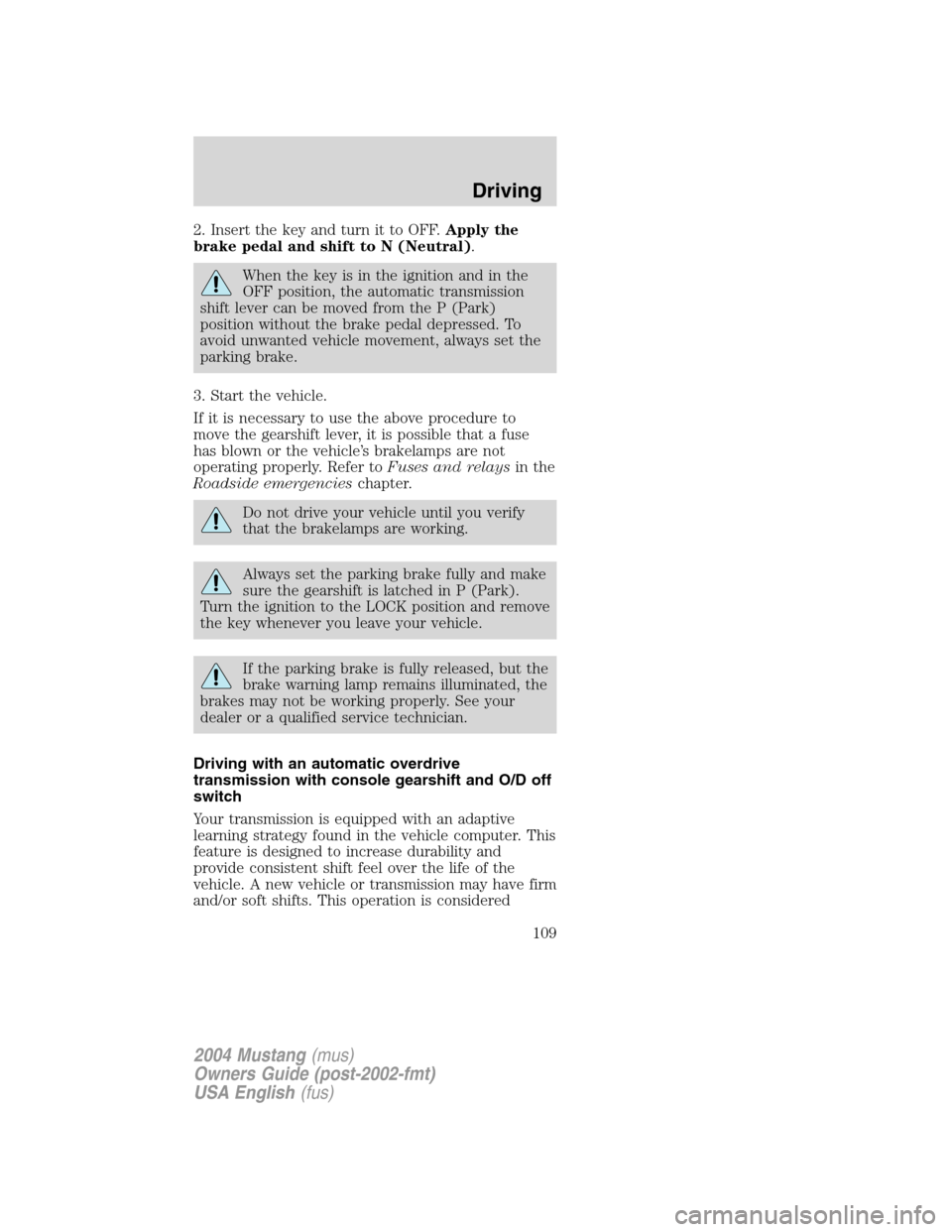
2. Insert the key and turn it to OFF.Apply the
brake pedal and shift to N (Neutral).
When the key is in the ignition and in the
OFF position, the automatic transmission
shift lever can be moved from the P (Park)
position without the brake pedal depressed. To
avoid unwanted vehicle movement, always set the
parking brake.
3. Start the vehicle.
If it is necessary to use the above procedure to
move the gearshift lever, it is possible that a fuse
has blown or the vehicle’s brakelamps are not
operating properly. Refer toFuses and relaysin the
Roadside emergencieschapter.
Do not drive your vehicle until you verify
that the brakelamps are working.
Always set the parking brake fully and make
sure the gearshift is latched in P (Park).
Turn the ignition to the LOCK position and remove
the key whenever you leave your vehicle.
If the parking brake is fully released, but the
brake warning lamp remains illuminated, the
brakes may not be working properly. See your
dealer or a qualified service technician.
Driving with an automatic overdrive
transmission with console gearshift and O/D off
switch
Your transmission is equipped with an adaptive
learning strategy found in the vehicle computer. This
feature is designed to increase durability and
provide consistent shift feel over the life of the
vehicle. A new vehicle or transmission may have firm
and/or soft shifts. This operation is considered
2004 Mustang(mus)
Owners Guide (post-2002-fmt)
USA English(fus)
Driving
109
Page 116 of 240
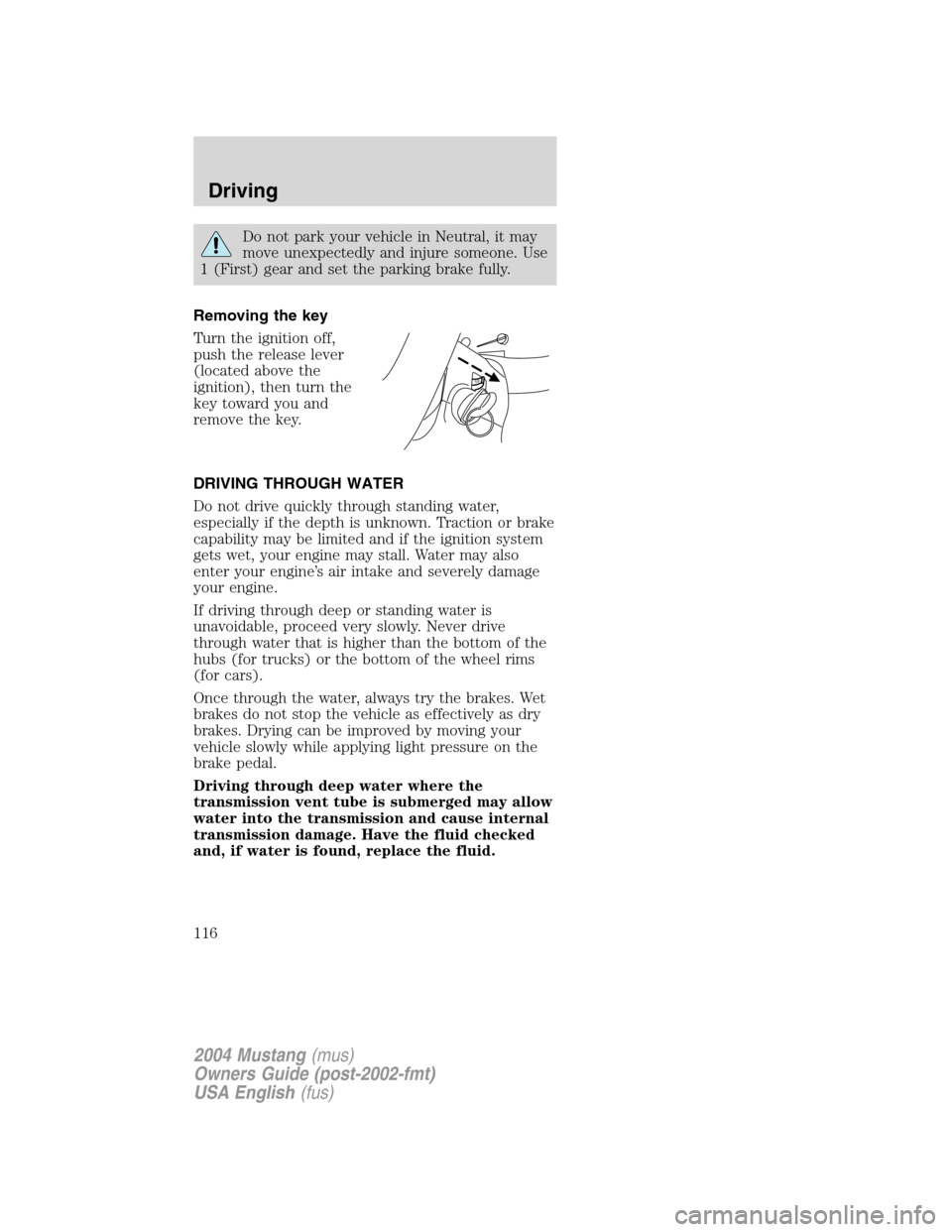
Do not park your vehicle in Neutral, it may
move unexpectedly and injure someone. Use
1 (First) gear and set the parking brake fully.
Removing the key
Turn the ignition off,
push the release lever
(located above the
ignition), then turn the
key toward you and
remove the key.
DRIVING THROUGH WATER
Do not drive quickly through standing water,
especially if the depth is unknown. Traction or brake
capability may be limited and if the ignition system
gets wet, your engine may stall. Water may also
enter your engine’s air intake and severely damage
your engine.
If driving through deep or standing water is
unavoidable, proceed very slowly. Never drive
through water that is higher than the bottom of the
hubs (for trucks) or the bottom of the wheel rims
(for cars).
Once through the water, always try the brakes. Wet
brakes do not stop the vehicle as effectively as dry
brakes. Drying can be improved by moving your
vehicle slowly while applying light pressure on the
brake pedal.
Driving through deep water where the
transmission vent tube is submerged may allow
water into the transmission and cause internal
transmission damage. Have the fluid checked
and, if water is found, replace the fluid.
PUSH
2004 Mustang(mus)
Owners Guide (post-2002-fmt)
USA English(fus)
Driving
116
Page 119 of 240
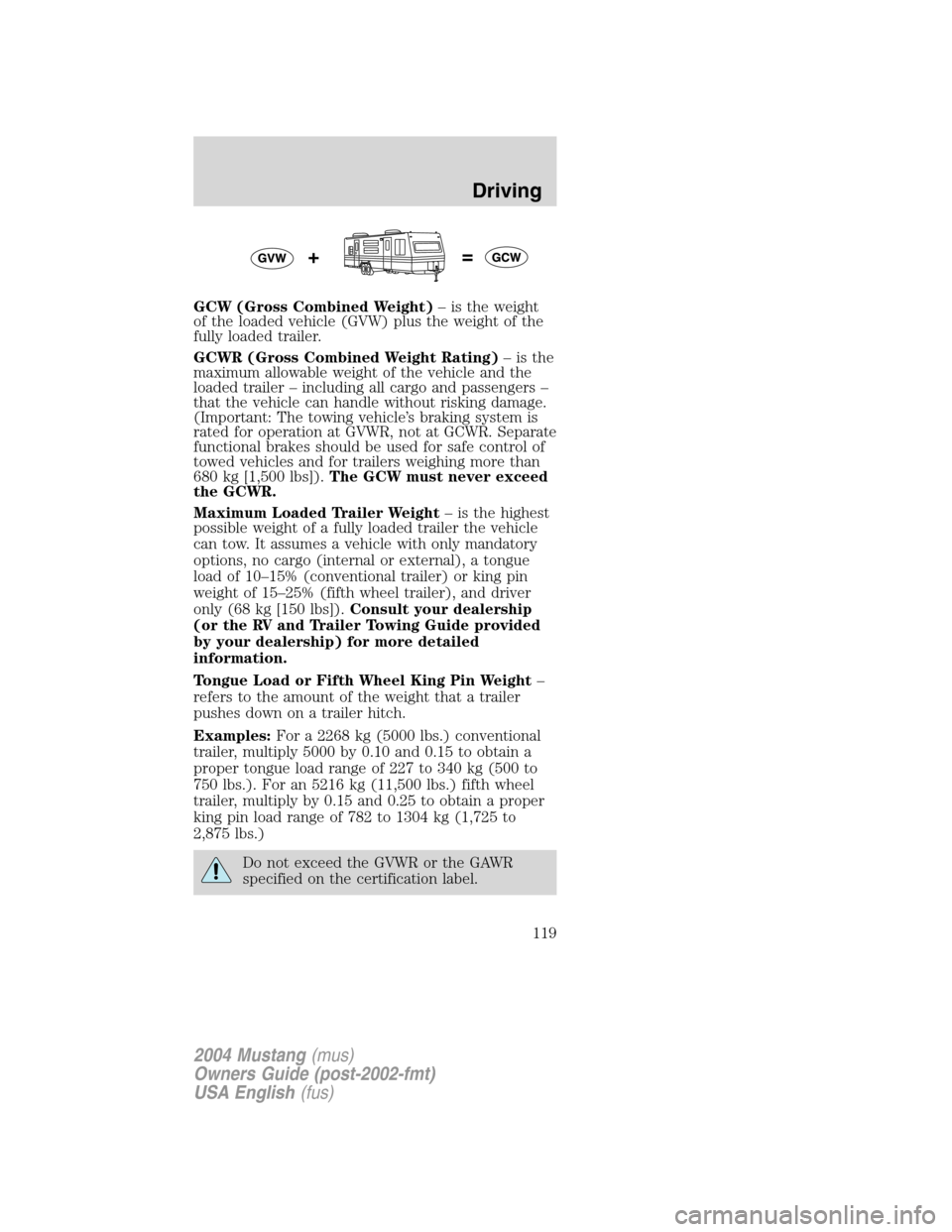
GCW (Gross Combined Weight)–is the weight
of the loaded vehicle (GVW) plus the weight of the
fully loaded trailer.
GCWR (Gross Combined Weight Rating)–is the
maximum allowable weight of the vehicle and the
loaded trailer–including all cargo and passengers–
that the vehicle can handle without risking damage.
(Important: The towing vehicle’s braking system is
rated for operation at GVWR, not at GCWR. Separate
functional brakes should be used for safe control of
towed vehicles and for trailers weighing more than
680 kg [1,500 lbs]).The GCW must never exceed
the GCWR.
Maximum Loaded Trailer Weight–is the highest
possible weight of a fully loaded trailer the vehicle
can tow. It assumes a vehicle with only mandatory
options, no cargo (internal or external), a tongue
load of 10–15% (conventional trailer) or king pin
weight of 15–25% (fifth wheel trailer), and driver
only (68 kg [150 lbs]).Consult your dealership
(or the RV and Trailer Towing Guide provided
by your dealership) for more detailed
information.
Tongue Load or Fifth Wheel King Pin Weight–
refers to the amount of the weight that a trailer
pushes down on a trailer hitch.
Examples:For a 2268 kg (5000 lbs.) conventional
trailer, multiply 5000 by 0.10 and 0.15 to obtain a
proper tongue load range of 227 to 340 kg (500 to
750 lbs.). For an 5216 kg (11,500 lbs.) fifth wheel
trailer, multiply by 0.15 and 0.25 to obtain a proper
king pin load range of 782 to 1304 kg (1,725 to
2,875 lbs.)
Do not exceed the GVWR or the GAWR
specified on the certification label.
2004 Mustang(mus)
Owners Guide (post-2002-fmt)
USA English(fus)
Driving
119